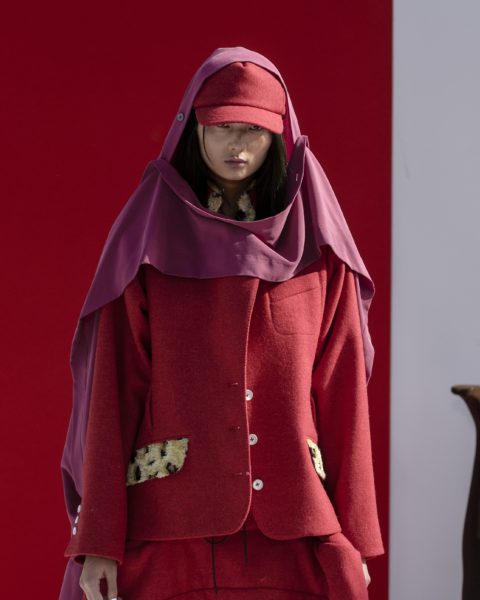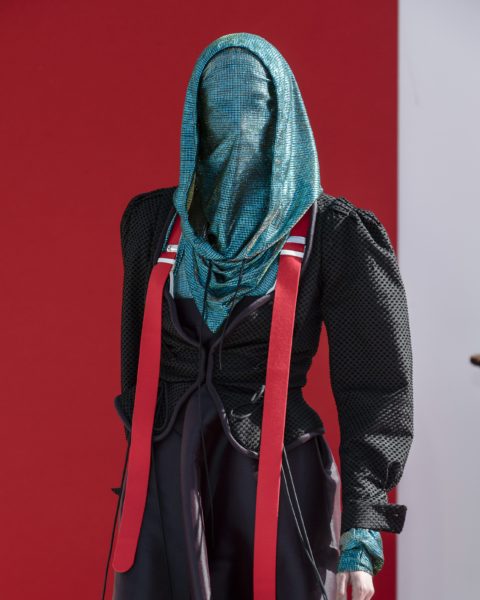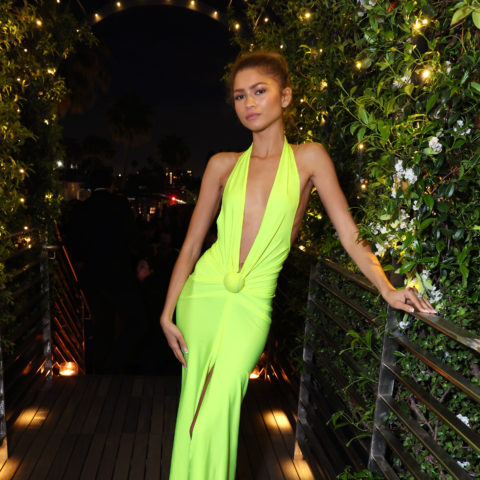What the Heck is Going on With Vivienne Westwood’s Fall 2018 Show?
The collection was purportedly inspired by Dame Vivienne Westwood herself, but featured hijabs, burqas and...plagiarism?
Andreas Kronthaler for Vivienne Westwood put on a grotesquely sexy runway show at Paris Fashion Week. To set the mood, three towering gothic gogo dancers gyrated on elevated podiums to an industrial beat, while models walked the runway wearing loosely designed approximations of the hijab paired with stripper heels, and burqas by way of Leigh Bowery, which veered into fetish territory when it became apparent they had no panels for the eyes.

Considering how Gucci’s Fall 2018 collection was slammed for cultural appropriation for its use of turbans and headscarves, it seems odd that there’s been nary a peep from the fashion establishment considering whether these designs veer into the territory of cultural appropriation. While “ethnic futurism” has become a buzzword this season thanks to Gucci and Etro, Westwood’s designs still came across as somewhat clueless. Odder still, the collection was described as an “homage” to Vivienne by Kronthaler, whom he described as “my collaborator, my friend and partner, my teacher and of course as my muse” in a love letter distributed to guests. Dame Vivienne herself is, as far as public record goes, not a Muslim.
Also strange was the self-imposed plagiarism controversy the appeared after the show on Instagram. Hours after the show, Westwood posted an apology on Instagram for lifting the text of a t-shirt from Rottingdean Bazaar, a new British independent label, and the squiggly writing on top of the text from Louise Gray, a designer who has been described as “a worthy heir to Dame Vivienne Westwood’s throne.”
The apology on Westwood’s Instagram read, “Dear @louisegray_ and @rottingdeanbazaar. We are sorry. The use of your graphics on our t-shirt was only ever meant to be a celebration of your work. We got caught up in a last minute frenzy and did not contact you to ask permission. We are truly sorry about this mistake and want to make it up to you.”
Mistakes happen, understandably, but this is not the first time Andreas Kronthaler has stumbled in the ‘asking for permission’ department. In 2016, Spanish artist Roberta Marrero had found that Westwood had slapped one of her works, a collage featuring a man with a mustache surrounded with doodles, onto a t-shirt for which they charged 300 Euros. The shirt was again, reportedly designed by Kronthaler, the brand also described that incident as a “mistake.” At the time, Marrero told Spanish newspaper La Provincia that the label had contacted her about the incident and they were “negotiating to correct it.”
And yet, the mistake seem like less of a simple flub in the context of the advice Westwood once gave to fashion students: copy, copy, copy. “I taught fashion, and I started off getting students to copy things,” the 76-year-old designer said in an interview with Fashionista in 2015. “That’s the only way to learn things. A young person has experience up to a point, and they can do something and it might be very good, but you can’t do something for very long if you don’t have the ideas coming, you know.”

It all seems rather rich considering a designer named Anthony Knight was once threatened with jail time for allegedly copying some of the slogans on her infamous 1970s punk t-shirts including “Too Fast To Live, Too Young to Die,” and “Let it Rock.” However, he also reportedly copied her trademark-protected orb logo which is indeed a criminal offense.
An accident is just that because no one intends for it to happen. But Kronthaler’s unfortunate history of lifting other people’s work and passing it off as his own is more evidence of sloppy work ethic than genuine mistake. Vivienne Westwood has PR and communications people working for the brand, so it seems suspect that there wasn’t one person who thought to reach out to Rottingdean Bazaar and Louise Gray before the show pictures went up on Vogue Runway.
Since her fashion career began in in 1970s, Westwood’s primary goal has been to provoke. By pairing swastikas with Jesus on an inverted cross on a t-shirt Westwood’s goal was to give a giant middle finger to the old fogies who had actually lived through WWII and tiptoed around the subject. But it’s time to admit that provocation as a means to jostling people into a state of awareness has aged terribly as a tactic of engagement.
Now, there’s no way subverting an offensive symbol (like a swastika) or one with specific religious meaning (like a hijab or burqa) and blaming the offended party for being too sensitive would be considered anything other than inconsiderate and unrepentantly mean.

Westwood’s pairing of Muslim religious garments with stripper heels is the oldest trick in the book – pairing two things that traditionally oppose each other – to create the friction of juxtaposition. At The Cut, Stella Bugbee writes that when glamour is predicated on transgression it often comes at a human cost. She may have been referring to the fetish fantasy that many male photographers have used to push boundaries in their work, but the concept can also be applied to the way fashion garments are created, styled and presented.
At this point, fashion needs take a deep breath — perhaps spend an hour in a sensory deprivation tank — and accept that boundary-pushing isn’t as valuable an artistic currency as it once was.








